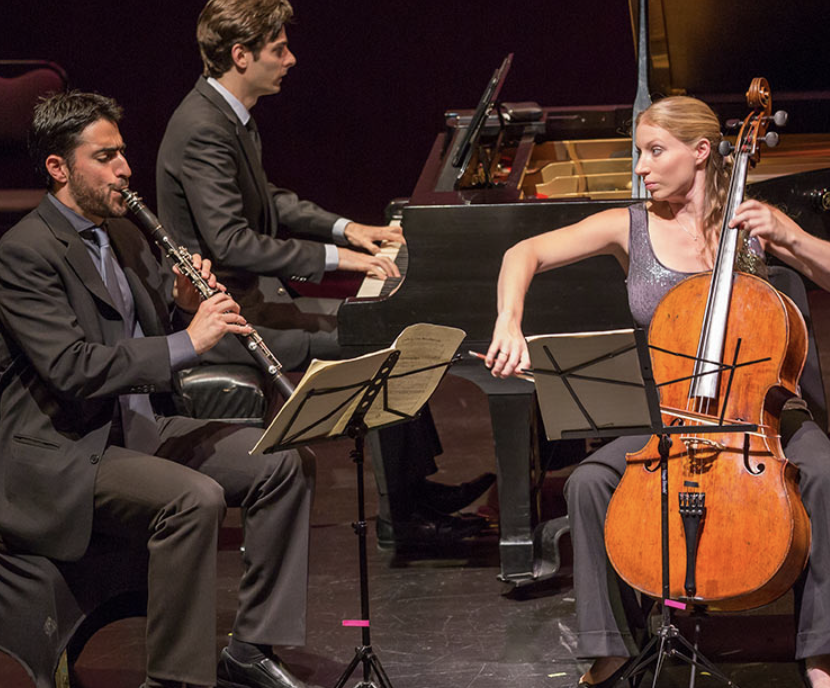|
Symphony
FROM THE NEW WORLD TO THE OLD WORLD
by Peter Lert
Saturday, June 14, 2025
Chamber
MC2 DUO RECITAL CLOSES 222'S SEASON
by Terry McNeill
Saturday, June 14, 2025
Choral and Vocal
CANTIAMO SONOMA'S LUSCIOUS A CAPELLA SINGING IN SEASON ENDING CONCERT
by Pamela Hicks Gailey
Sunday, June 8, 2025
Symphony
SRS SEASON ENDS WITH RESOUNDING TA-TA-TA-BANG
by Terry McNeill
Sunday, June 1, 2025
Symphony
YOUTHFUL VIRTUOSITY ON DISPLAY AT USO'S MAY CONCERTS
by Peter Lert
Saturday, May 17, 2025
Symphony
MYSTICAL PLANETS AND LIVELY GERSHWIN ORTIZ AT FINAL SRS CONCERT
by Peter Lert
Sunday, May 4, 2025
Symphony
VSO'S CONCERT MUSIC OF TIME, MUSIC OF PLACE
by Peter Lert
Sunday, April 27, 2025
VOCAL ELEGANCE AND FIRE AT THE 222'S RECITAL APRIL 26
by Pamela Hicks Gailey
Saturday, April 26, 2025
CANTIAMO SONOMA SINGS AN INSPIRED GOOD FRIDAY MOZART REQUIEM CONCERT
by Pamela Hicks Gailey
Friday, April 18, 2025
DRAMATIC SHOSTAKOVICH SYMPHONY CLOSES PHILHARMONIC'S 25TH SEASON
by Terry McNeill
Sunday, April 13, 2025
|
 |
 Israeli Chamber Project |
BRAHMS-ERA TRIOS HIGHLIGHT OAKMONT CHAMBER CONCERT
by Nicholas Xelenis
Thursday, May 5, 2022
The Music at Oakmont concert May 5 in Berger Auditorium was attended with mostly masked patrons who were buzzing at the door and then made an effort to get close to the stage to hear the piano trio from the Israeli Chamber Music Project.
Bergerís sonics were a bit of a challenge for the musicians with the constant sound of AC, circulating fans and the hallís legendary dead reverberation. Each member of the trio is a founding member of the Project, and pianist Assaff Weisman also served as MC to announce details of the programís music from mostly the 19th Century, and mostly revolving around Brahms.
Clarinetist Tibi Cziger is a passionate soloist and performed on the Selmer Privilege Model instrument with beautiful tone colors, finger control, accurate intonation and complete command of registers and expression. The program of four composers were all from the 19th Century with one composer, Alban Berg, thrown in to offer an abrupt change of musical style and compositional technique.
The suite from Korngoldís Much Ado About Nothing (Op. 11) for cello and piano showcased Michal Kormanís luscious cello sound and her warm projecting melodious tunes that were both harmonically pleasing and daring. With tonality in a conventional style of the period, the melodies were simple and daring for cellist and showing her virtuosity in all the celloís registers. In the first movement (The Maiden In the Bridal Chamber) was an hors d'oeuvres for the following two movements. The Korman-Weisman duo played the subdued but gripping themes in pianissimo and were always carefully balanced, and Ms. Michalís bow control was deft, as she would play just short of the celloís bridge to project expanded dynamic contrast in the music. There was elegant phrasing and tapering at ends of phrases.
The Dogberry and Verges second movement was reminiscent of Prokofievís march from the Lieutenant Kije Suite, followed by the lush cello melody (In the Garden) as the piano line provided the bubbling water rhythmic chords and arpeggios. Masquerade, the finale, was played a jaunty manner, each instrument playing with the beguiling themes.
Zemlinskyís Trio (Op. 3) for Clarinet, Cello and Piano, closed the first half, and the music was an echo of the famous Brahms trio which was performed later in the program. Playing in the first movement was graceful, with Mr. Weisman often deferring to the cello part, and the clarinet line deftly became a warm three-part statement. In the Andante Mr. Cziger used rotary breathing for an extra-long phrase which many clarinetists aspire to accomplish, and he connected phrases effortlessly. The pianissimos were stunning.
The finale was that of a Scherzo, and the instrumental balance was beautiful in the passing of melodies, joining together as unison, and supporting the theme with ever winding and rhythmical accompaniment. The sound of the piano never overpowered the clarinet or cello.
The contemporary piece of the program was Webernís Four Pieces for Clarinet and Piano, Op. 5, written in 1904. It seemed a micro bit of expressionism that moved to of whimsy, but was a technical, emotional, and mental challenge. While the work is similar to the composerís exploration of short forms, the Opus Five is brimming with elements of expressionism that effortlessly conveyed a turbulent emotional landscape in a manner no less effective than a much lengthier Brahms sonata. Technical mastery of the clarinet is required, and the audience seemed to be engaged and followed the disjointed rhythmic instability with effects like flutter tonguing and sudden register changes, a Berg trademark.
Brahmsí Op. 114 A Minor Trio is a chamber music gem. In the opening Allegrothe performance had depth, the cello leading and then the clarinet line enters. The development sectionís difficulty of displaced beats was mastered, as was the composerís frequent use of shifts between triple and duple meter. In his Academic Festival Overture he composed a rhythmic passage where the strings followed the woodwinds by an eight note for 16 measures, giving the appearance of a drunken melody. Brahmsí inner humor was on display here.
The slow movement was played divinely, with great reverence and a deep meditative quality. Cello and Clarinet lines formed an indisputable combination of colors, expression, tone. The light Andantino was Brahmsí version of a Viennese Waltz. The playful three-quarter time included playing intertwining themes and bubbly arpeggios from both the Clarinet and Cello. The 4th movement took off with a rhapsody of rolling sixteenth notes rippling from each instrument, the counterpoint of the trio captivating. It was the afternoonís highlight.
No encore was offered.
|

